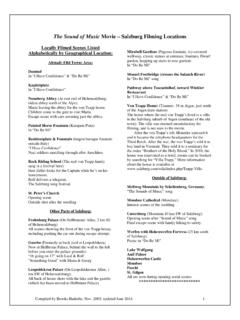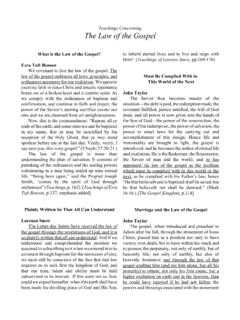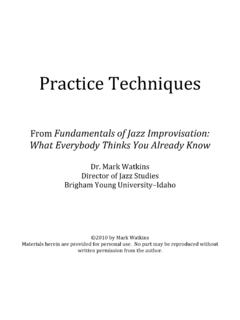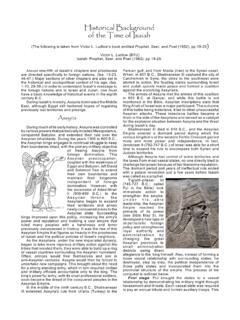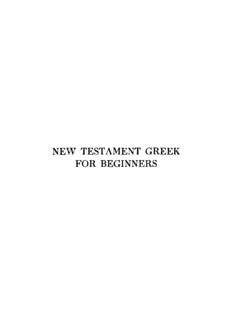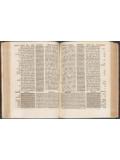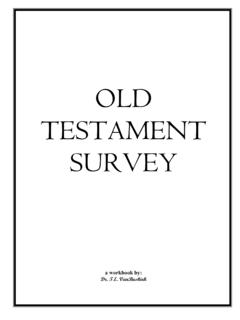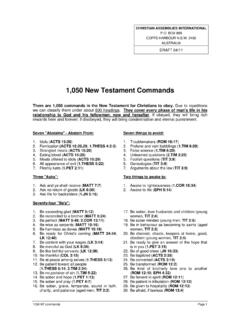Transcription of The Historical Background to the New Testament
1 The Historical Background to the New TestamentBruce SatterfieldBrigham Young University - IdahoThe Return of the Jews and the End of the Old TestamentIn 587-6 , the Jews in Jerusalem fell prey to theexpanding Babylonian empire. Jerusalem was destroyed andmany Jews were taken captive to Babylon. However, by , the Babylonians were conquered by the Persians. Cyrus,king of Persia, reversed the Babylonian practice of repressionof nationalism by allowing those nations who had beendeported by the Babylonians to return back to their homelandsand to worship their own gods. Cyrus allowed returningcaptives to take with them the religious objects which theBabylonians claimed as booty. He also provided them somefunds to help rebuild local religious shrines. He hoped thatthis generosity would create local governments who were loyalto him.
2 The Jews taken captive by Babylon benefitted from Cyrus policy and were allowed to return to Jerusalem. Cyrus edictallowing the Jews to return to Jerusalem is found in Ezra (1:2-4; 6:3-5). Over the next century and a half, numbers of Jewsreturned to rebuild Jerusalem and her temple. The books ofNehemiah and Ezra tell the story. The return to the homeland was not forced. Those whowished to stay in Babylon could. These Jews were the childrenand grandchildren of the Jews who had been exiled byBabylon. They had acquired property and sunk roots inBabylon. As a consequence the majority of the Jews remainedin Babylon where many had established a strong Jewishcommunity. In fact, during the succeeding centuries numbersof Jews began to migrate to many areas of the Near East,Europe, and Africa so that by the time of Christ Jews werefound in most parts of that ancient world (for a listing ofcountries see Acts 2:9-11).
3 The areas where Jews were livingoutside of Jerusalem and Judea became known as the Return of the Jews to JerusalemTwo important accomplishments were realized by thereturning exiles. First the temple was rebuilt. Second, the lawof Moses became the center of Jewish life. This happened inthe following way. Shortly after Cyrus edict, a group of Jews led bySheshbazaar, of the Davidic line, returned to , the situation in Jerusalem was difficult and the groupfailed to make much progress in securing Jerusalem andrebuilding the temple. In 520 , a second group of exilesreturned to Jerusalem led by two men named Zerubbabel,nephew to Sheshbazaar, and Joshua. Under their leadership, and through the inspiration of theprophet s Zachariah and Haggai, the temple was rebuiltalthough its structure cannot be compared to the grandeur ofSolomon s temple.
4 The building of the temple began what isknown as the second temple period. As we shall see, it was thistemple that Herod the Great greatly enlarged and remodeled. With the rebuilding of the temple came the reestablishmentof the old hierarchical social structure which had come todominate Jewish (and Israelite) society before the exile. It hasalready been shown that this kind of social structure is oftenoppressive, especially to the peasantry that makes up themajority of the population. The oppressive nature of thisstratified social structure was felt in the days of Nehemiah(Neh. 5:1-5) who enacted various reforms in an attempt toreduce the burden of dept created by the structure. But thesereforms were only temporary. Sometime after the temple was rebuilt (the date is verymuch disputed), a second group of exiles returned to Jerusalemled by a priest named Ezra.
5 Ezra was a ready [skilled] scribein the law of Moses (Ezra 7:6). Through the work of Ezra,idolatry was eradicated out of Jewish society. Further, the lawof Moses became the preeminent law of the Jews, somethingthat had rarely happened since Moses. Because of this, Ezra issometimes referred to as the second Moses. Ezra also established a new class of religious leaders whowere studied in the law. Prior to this time the religious leadersof the Jews were priests and prophets. But at this time, therewere no prophets any more and the priests concernedthemselves solely with temple rituals. These new religiousleaders, called scribes, replaced the priests as those whointerpreted the law of Moses and taught the law to the their help, many in the Jewish community becamededicated to the study of the law.
6 During the Persian Period (c. 515-332 ), the Jewishcommunity was localized in a twenty-mile radius of , Jerusalem was a small temple-state. Though thetemple and priesthood were reestablished as it was in the daysbefore the exile, the monarchy was not. The political andreligious leader of the Jews was a high priest of Zadokitedescent. (The Zadokites were descendants of Zadok, who wasinstalled as high priest by King David. From that time forth,all high priests were to be descendants of Zadok.) They weresubject to the Persian governor of the area but were notappointed by and the End of the Old TestamentEither before or after Ezra came the ministry of the lastprophet of the Old Testament , Malachi. He spoke out againstthe priesthood which had become lax and careless in theirduties.
7 Moreover, the same priesthood had departed out ofthe way and caused many to stumble at the law having corrupted the covenant (Mal. 2:8). He prophesied that thesons of Levi would be purified as gold and silver that theymay offer unto the Lord an offering in righteousness ( :3). He ended his prophecy, and thus the Old Testament , witha most significant prophecy: the Lord would send Elijah before the coming of the great and dreadful day of the Lord to turn the heart of the fathers to the children, and the heart ofthe children to their fathers (Mal. 4:5-6). This is where the Old Testament Inter-Testamental PeriodThe greek PeriodIn 334 , the Greeks, led by Alexander the Great,conquered the Persian empire including Judea, the name givento the province where Jerusalem was located.
8 In 323 ,Alexander died and his empire, which extended from Greeceto India, was divided among his four generals. Judea cameunder the control of Ptolemy, who ruled Egypt and Palestine,while Syria and Babylon was ruled by Seleucus. However, in198 , Antiochus III, a Seleucid king, conquered Palestine,including Judea. Judea remained under Seleucian control untilthe Jews gained independence as a result of the Maccabeanrevolt which began in 167 This will be discussed the greek , or Hellenistic, period isimportant in the study of the New Testament . Though theRomans ruled the world of the New Testament , it was theGreek culture that predominated. Of this period, FrederickMurphy has written: Alexander believed in the superiority ofGreek culture, but was at the same time somewhat open toother cultures.
9 Alexander wanted to put into practice the ideathat all the world was a single city and all people inhabitants ofthat city. Alexander was pursuing a cosmopolitan ideal (fromthe greek kosmos meaning world and polis meaning city ),but it was an ideal based on the conviction of the superiority ofGreek views of the world and greek institutions. 1 UnderAlexander and his successors, Hellenism (the greek way oflife) was aggressively can be seen from Murphy s comment, the maininstitution of greek culture was the greek city. These citieswere ruled by the citizens (citizens were usually the land-owners). Common to all greek cities was the agora, themarketplace. The agora was a large open square, oftensurrounded by porticoes ( greek : stoa), porches with open sidesand a roof held up by rows of columns.
10 The agora also servedas a marketplace for ideas where philosophers could get ahearing. Religious missionaries could do likewise. 2 You could also find theaters and gymnasiums in a Greekcity. In the theater, plays immortalized greek mythology andsociety was both praised and satirized. The gymnasium wasmuch more than a place for sports, although sports were animportant medium of social interaction and helped tosubstantiate the greek idea of a sound mind in a strong also served varied social functions, from meetingplaces for political clubs, to a kind of high school for Greekboys. The high school taught the classics and trained the boysmilitarily. The gymnasium was a key vehicle for preserving,spreading, and transmitting greek culture. 3 Temples were also a major part of the greek city.

